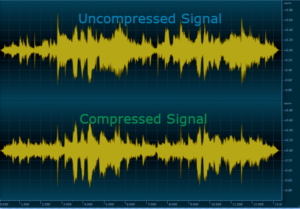Search Topic
Music Compression
Music Compressors are one of the most important tools for audio production and mixing. Music compression is the process of reducing a signal’s dynamic range. There are quite a few buttons on a compressor and knowing what each of these buttons does and how they work together is an important way to understand how to use compression effectively.
Compression Parameters
There are a few parameters and controls used in audio compression that allow working with a wide range of compressors.
• Threshold – The threshold regulates the level of the initial signal. When that signal reaches the threshold it starts compressing accordingly. This is a conjunction with the ratio is the most important parameter of a compressor and they work together to create specific compression sounds.
• Ratio – Ratio is the comparison to the unaffected signal. Here the required compression and signal over and above the threshold should be mentioned. If a signal crosses the threshold by 4 dB and the ratio is set to 4:1, the compressor will compress it down and only allow 1 dB to come through. It specifies the amount of attenuation applied to the signal. It regulates the gain reduction.
• Attack – You can make a compressor clamp down on a transient with a fast attack, or you can set it slower, letting the attack of the instrument come through before compressing it.
• Release – When do you want the compressor to stop working after it has dropped below the threshold? A long release can create an unflattering constant compression effect.
• Knee – It is the determinator of the kick start of the signal. It can be of two types – Soft knee & Hard knee. A soft knee applies compression gradually but a hard knee setting makes the compressor kick in immediately. It is the compressor transitions between the non-compressed and compressed states of an audio signal running through it.
• Gain Reduction Meter – The most important meter on your compressor. This shows the level of the signal of compression. Also how fast it starts and stops working.
• Output/Makeup Gain – Here the amount of volume can be compensated with losing by compressing with the make-up gain. Since you are reducing dynamic range, you are also reducing a little volume. If your compressor lowers the volume of the signal you can increase it again here.
Types of Compression
Subtle compression
Subtle compression is taming the dynamics in such a way that you don’t squash a signal and render it lifeless, but rather that you control the peaks by compressing the loudest parts while the rest stays unaffected.
It can be created with a low ratio, like 2:1 – 3:1, and setting the threshold in a way that it just lightly tickles the peaks of a signal.
Push the threshold down until you see light compression going on in the gain reduction meter when the designated instrument plays a little louder. Play around with the attack and release to get that perfect light compression you want.
Over-compression
It can be created with a high level of ratio. So, this is the exact opposite of subtle compression since we are pushing the threshold down until it affects the whole signal all the time. This can be cool for effects or trying to get a special sound but it can also suck the signal dry, leaving you with an unnatural and dull sound.
It’s easy to give a specific sound a squashed and over-compressed effect.
Limiting
Limiters work similarly to compressors, except that there is no compression exist.
What a signal goes over the pre-determined threshold, a limiter doesn’t compress a signal down according to a 2:1, 3:1, or 4:1 ratio. What it does is cut off every part of the signal that goes over the threshold, thereby limiting it. This can be handy to lightly control peaks and maximizing levels without the sound of pumping over-compression. Limiters can be used to reduce the peaks of signals subtly.









